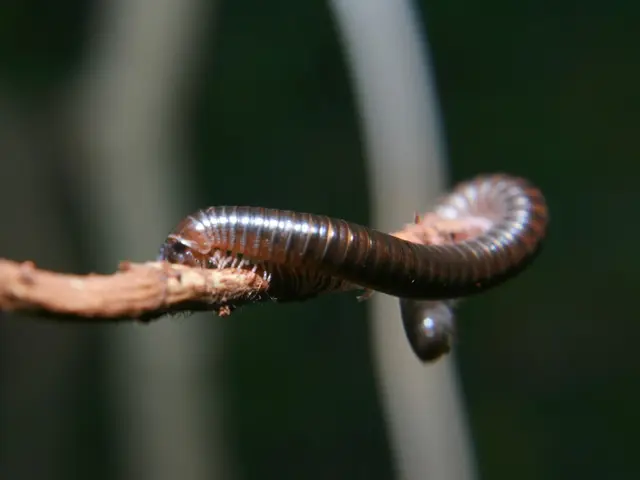Distinguishing Age Spots from Skin Cancer: Recognizing Signs and Warning Symptoms
Age spots and cancerous growths on the skin might look similar at first glance, but it's important to know the differences between them. Here, we're breaking down age spots and skin cancer, discussing their symptoms, diagnosis, and treatments:
Differences Between Age Spots and Skin Cancer:
Age spots and skin cancer often appear on areas exposed to the sun, like the face, hands, or shoulders. However, unlike skin cancer, age spots are harmless and do not threaten your health.
Age Spots
Age spots, also known as solar lentigines or liver spots, are small, darker patches on the skin, usually yellow, brown, or gray. They are typically flat and smooth and without any itchiness or discomfort. Age spots develop when the body produces excess melanin to protect the skin from UV radiation damage, causing the skin to darken[1][3].
Skin Cancer
Skin cancer is a type of cancer that can be life-threatening if not caught early. Skin cancer forms when the skin is damaged by UV radiation or other factors, causing the skin cells to mutate, grow, and spread at an accelerated rate. The three most common types of skin cancer are basal cell carcinoma, squamous cell carcinoma, and melanoma[2].
If you suspect you have skin cancer, key differences in appearance, texture, and placement can help you identify it:
Symptoms of Age Spots and Skin Cancer:
Age Spot Symptoms
- Flat and smooth
- Yellow, brown, or gray
- Defined borders
- Sizes ranging from a few millimeters to centimeters
- Located on sun-exposed areas like the face, hands, shoulders, feet, arms, or back
- Age spots may fade in winter and become more pronounced in summer[1]
Skin Cancer Symptoms
- Asymmetrical shape
- Irregular, blurred, or ragged edges
- Changing size, color, or shape
- Multiple colors on the same spot
- Pink, blue, purple, black, or brown coloring
- Raised, red patches
- Pale or yellow firm patches, similar to scars
- Pain, itching, oozing, or bleeding
- Crusty or scaly patches
- Raised edges that lower in the middle[1][2]
If you notice any symptoms, take action and consult a healthcare professional immediately for proper diagnosis.
What to Do if You Suspect Skin Cancer:
If you suspect you have skin cancer, it's important to act quickly. Seek medical advice if you have a mark on the skin that changes in color, shape, size, or location; looks different from other marks on the skin; itches, crusts, scabs over, or bleeds and does not heal within four weeks[1].
Once you consult a doctor, they will likely perform a physical examination of the skin, assessing appearance, texture, and placement of the spot to determine if it's a sign of skin cancer[3]. If they are unsure, they may perform a skin biopsy to test for other conditions. The results of a skin biopsy will indicate if you have skin cancer or another skin condition[4].
Treatments:
Age Spots
Since age spots are harmless, treatment is generally not necessary unless you want to improve their appearance. Options for reducing the appearance of age spots include topical creams, chemical peels, microdermabrasion, or laser treatments. Your dermatologist can recommend the best treatment for you[4].
Skin Cancer
Depending on the type and stage of skin cancer, treatment options vary. In some cases, doctors may surgically remove basal cell and squamous cell cancers[5]. For more advanced cases, treatments can include topical therapies, radiation therapy, chemotherapy, immunotherapy, or systemic medication.
In summary, understanding the differences between age spots, actinic keratosis, and skin cancer is essential to identify signs of skin cancer early and seek proper treatment. Consult a healthcare professional if you notice any changes in your skin that concern you. Early detection is crucial for effective treatment and improved health outcomes.
References:[1] American Cancer Society. (2020). Signs of Skin Cancer. https://www.cancer.org/cancer/skin-cancer/signs-symptoms-of-skin-cancer.html[2] American Cancer Society. (2020). Skin Cancer - Types. https://www.cancer.org/cancer/skin-cancer/types.html[3] Mayo Clinic. (2020). Age spots: Treatment, removal, and prevention. https://www.mayoclinic.org/healthy-lifestyle/adult-health/expert-answers/age-spots/faq-20058460[4] Mayo Clinic. (2019). Age spots. https://www.mayoclinic.org/diseases-conditions/age-spots/diagnosis-treatment/drc-20368643[5] American Academy of Dermatology. (n.d.). Actinic Keratosis. https://www.aad.org/public/diseases/skin-cancer/actinic-keratosis
Enrichment Data:- Age spots, skin cancer, and actinic keratosis may appear similar but have marked differences in appearance, texture, and symptoms.- Early detection and proper treatment of skin cancer are crucial for improved health outcomes.- Age spots are mainly of cosmetic concern, while skin cancer can be life-threatening if left untreated.- Common skin cancer types include melanoma, basal cell carcinoma, and squamous cell carcinoma.- Age spot treatment options include topical creams, chemical peels, and laser therapy, while skin cancer treatments depend on factors such as type, stage, and overall health.
- In the realm of oncology, it's crucial to distinguish age spots from skin cancer, as they may seem similar initially.
- Skin cancer, being a type of medical-condition that can threaten health and lives, requires immediate attention, whereas age spots pose no such risk.
- Dermatology, the branch of science focusing on skin conditions, offers various treatments for age spots, such as topical creams or laser therapy, to improve their appearance, unlike cancer.
- Cancer, particularly melanoma and other types, develops due to skin damage from UV radiation or other factors, while age spots are caused by overproduction of melanin as a response to UV damage.
- Senior individuals are not exempt from being aware of potential skin cancer risks, as it can occur in any age group, demanding vigilance regarding health-and-wellness and skin-care practices.








